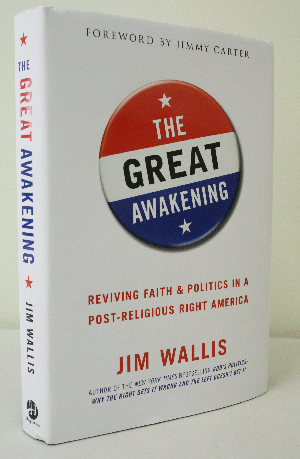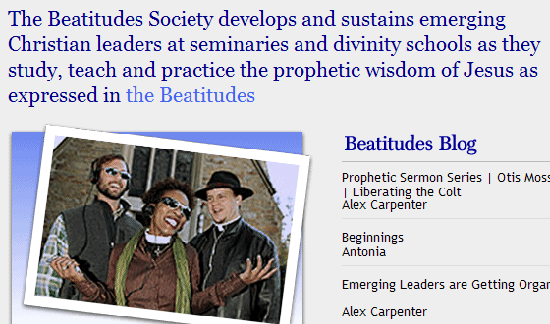
젊은 복음주의 세대 중 한 명인 크리스 라톤드레스(Chris LaTondresse)가 이번 행사에 동행했다. 그는 어린 시절 소비에트 연방에서 자란 선교사 집안의 자녀로, 최근 미네소타 세인트폴의 벧엘대학을 졸업했다. 그와 나는 행사와 교회, 복음주의권 대학 교정에서 여러 젊은이를 만나 대화를 나눴다. 이 대화를 통해 분명히 인식하게 된 것은, 보수주의적인 교회에서 자라나고 있는 교회 출석자들이 마침내 평화와 정의의 문제에 관해 성숙한 의식을 키워가고 있다는 사실이다. 새로이 출현하고 있는 이 세대는 진보적인 복음주의의 새로운 운동을 선도하고 있다.
보스턴을 방문한 나는 역사적인 파크스트리트교회에서 강연을 했다. 그곳은 두 번째 대각성 운동을 선도한 찰스 피니(Charles Finney)가 1831년에 설교했던 곳이다. 당시의 빌리 그래함이었던 피니는 사람들로 하여금 예수 그리스도에 대한 믿음에 붙들릴 것과 반노예제운동에 동참할 것을 요청했다. 피니는 실제로 '제단 초청' 의식을 시작한 사람으로, 그에 의해 회심한 사람들이 반노예제운동에 참여하게 되었다. 당시 또 한명의 유명한 반노예제 개혁 운동가는 보다 세속적이었던 윌리엄 로이드 개리슨(William Lloyd Garrison)이다. 그는 겨우 23살이었을 때 같은 교회에서 그의 첫 번째 노예제 폐지 연설을 했다.
그 주간 밤에는 파크 스트리트에 운집한 수백 명의 젊은 복음주의자들을 만났다. 그들은 오늘날 우리 시대 가장 취약한 상황에 처한 이들을 주목하며 새로운 '노예제폐지주의자' 세대가 되기 원한다. 그들은 불필요한 가난과 막을 수 있는 질병 때문에 매일 죽어가고 있는 전 세계 3만 명의 아이들을 예수가 돌보신다는 것을 깨닫고 있다.
캘리포니아 파사데나에 있는 풀러신학교에 방문했을 때는 참석한 많은 학생이 앉을 자리가 부족해 강단 뒤쪽 복도나 계단에 서 있을 정도였다. 같은 일이 시카고 외곽에 있는 휘튼대학에서도 일어났다. 이곳은 미국에서 가장 유명한 복음주의 학교다. 그리고 산타 바바라의 웨스트먼트대학에서도 마찬가지였다. 금요일 밤 학생들은 체육관에 빼곡히 들어찼다. 이들 중 많은 학생은 기독교의 이미지가 매우 안 좋다는 사실을 인식하고 있었다. 즉, 위선적이고, 심판적이며, 내세에 과도하게 관심을 기울이며 지나치게 당파적으로 보여진다는 것이다. 그들은 극히 새롭고 다른 무언가를 갈망하고 있다. 그렇지만 여전히 예수에게는 단단히 뿌리내린 채로 말이다.
젊은 복음주의자들은 홀로가 아니다. 더 넓고 새롭고, 영적으로 더욱 진보적인 가치관에 뿌리를 둔 운동의 한 흐름이다. 여기에는 많은 전통에 기반을 둔 종교인들과, "영적이지만 '종교적이지는 않은'" 이들, 또한 공적 삶이 도덕적 차원에서 펼쳐지기를 갈망하는 세속적인 청년들이 포함된다.
나는 가톨릭 청년들을 만났다. 그들은 자신의 교회가 제공하고 있는 공동의 선에 대해 사회적인 가르침을 발견하고 있다. 또한 주류 개신교 교회의 신학교 학생들도 만났다. 이들은 예수의 산상설교의 핵심 가르침을 연구하는 '지복 사회'(beatitudes societies)를 조직해 활동하고 있었다. 그들은 샌프란시스코의 그레이스성당에서 열린 우리 행사에 집단적으로 몰려왔다. 그들과 함께 온 젊은 흑인 목사들이 있었는데, 그들은 시민 권리 운동을 뒷받침했던 옛 찬송가를 부르기 원했지만, 또한 정의를 위해 투쟁하는 그들 자신의 역사를 만들고자 했다.

나는 사회적 정의의 맥락에서 '유대교의 갱신'을 갈망하는 젊은이들의 운동과, 극단주의에 맞서고 있는 모슬렘의 새로운 선지자적인 세대의 운동이 유사하다고 본다. 만일 이 새로운 세대를 만나면 운동의 에너지를 느낄 수 있을 것이다. 이것은 대부분의 언론이 지금까지 놓치고 있는 점이다.
바나 여론 조사 기관의 데이빗 킨나만(David Kinnaman)이 최근 자신의 저서 <비그리스도인>(unChristian>에서 시도한 양적 분석은, 이 Y세대 '인사이더'(교회 출석을 유지하던 청년들, 역자 주) 집단에서 질적으로 증명되고 있다. 즉, 교회 안에서 성장했지만 현 상황에 좌절감을 느끼는 이들이다. 그들은 앞으로 수년간 이 상황에 지각변동을 일으킬 것이다. 정치적으로뿐 아니라 신학적으로도.
정치적으로 그들의 의제는 더욱 폭넓고 깊다. 더 이상 단일한 당파적 이데올로기에 붙들려있지 않다. 하지만 그들은 투표를 한다. 이 유권자들은 선거가 그 자체만으로는 좀처럼 지니지 못하는 능력인, 정치를 실제로 변화시키는 능력을 발전시킬 수 있을 것이다.
신학적으로는, 이 젊은 복음주의자들이 예수 그리스도의 복음이 내세를 지향하는 '화재 보험'의 구원 정도로 축소시키려는 세계관을 버리고 있다. 이들은 마태복음 25장, 누가복음 4장, '시내산 설교'의 기독인들이다. 그들은 인격적이고 역동적이며 약동하는 신앙을 제시해주는 교회를 찾고 있다. 그들은 그러한 계기들을 통해 자신의 삶과 관계, 이웃, 국가와 세계를 변화시킬 수 있을 정도로 강력해지기 원한다. 그들은 진실로 하나님나라가 단지 내세만이 아닌 현재의 이 시대를 향한 하나님의 최선의 소망과 꿈을 나타내고 있다고 믿는다.
이들 젊은 기독인들에게 영향력을 발휘하던 종교적인 우파들은 예수로 대치되었다. 이는 진정한 진보다. 그들은 기독인들과 교회가 세상을 어떻게 변화시켜야 하는지에 대해, 즉, 어느 것이 <대각성> 세 번째 장인 '세상을 변화시키는 방법과 그 이유 : 언약의 율법'의 주요한 주제인지에 많은 관심을 기울인다. 그들은 또한 우리 시대의 커다란 문제들을 해결하는 데 헌신하도록 요청하는 이 책의 일곱 개 장에 주목하기 원한다. 왜냐하면 그것이 정확히 그들이 준비하고 있던 것이기 때문이다. 바로 헌신하는 일이다.
젊은 세대의 복음주의적 세계관은 새로운 지구 환경 속에서 단련되고 있다. 그들은 커피가 우러난 늦은 밤 세미나의 대화에서뿐 아니라, 미국 내 도시들의 붕괴된 잔해 속에서 살고 있는 가장 엄마들과, 멕시코의 쓰레기 더미에 살고 있는 어린이들, 동남아시아의 섹스 산업에서 구출 된 10대 소녀들, 그리고 사하라이남 아프리카의 어린 군인들과의 관계 속으로 자신들을 이끌어가는 선교 여행을 통해서 그러한 환경을 이해한다.
이 새로운 세대는 자신의 세상에서 일어나고 있는 것을 이미 목격했다. 그리고 자신들 안에서 신앙이 끓어오르고 있다. 바로 이러한 이유들 때문에 그들은 <대각성>이 전하는 메시지에 응답하고 있는 것이다. 그들은 1세기 랍비의 영원한 정통 신앙에 단단히 뿌리내리고 있으면서, 21세기 기독교의 새로운 비전을 똑똑히 밝히고자 하는 확신에 차 있다. 그리고 이 세대가 전면에 부상할 때면 그들은 모든 것을 변화시킬 수 있을 것이다.
짐 월리스 / <소저너스> 편집장 - 번역 최봉실
A Generation Comes of Age
These young evangelicals refuse to reduce the gospel to a "fire-insurance" salvation pitch.
From mid-January to mid-March, I traveled to 22 cities on my Great Awakening book tour. The most compelling evidence I saw that we really are entering a “post-Religious Right America” is the shifting political agenda and theological emphasis of a new generation of twentysomething evangelicals. I met thousands of them on the road as they came out in large numbers for book events.
I travel with one of these young evangelicals, Chris LaTondresse, a missionary kid who grew up in the former Soviet Union and who recently graduated from Bethel University in St. Paul, Minnesota. From the conversations he and I have been having with those in attendance at book events, churches, and evangelical college campuses, it’s clear that churchgoers growing up in conservative pews are finally coming of age with regard to peace and justice issues. This emerging generation is the leading edge of a new movement of progressive evangelicals.
In Boston, I spoke at the historic Park Street Church, where the premier evangelist of the Second Great Awakening, Charles Finney, preached in 1831. The Billy Graham of his day, Finney called people to faith in Jesus Christ and then to enlist in the anti-slavery campaign. Finney actually pioneered the “altar call” so he could sign up his converts for the anti-slavery campaign. Another famous anti-slavery crusader of the time, the more secular William Lloyd Garrison, delivered his first abolitionist speech in the same church when he was only 23 years old.
On that weekday night at Park Street, I encountered a packed church of hundreds of young evangelicals who want to be a generation of new “abolitionists” - focusing on the most vulnerable people in our world today. They suspect that Jesus would likely care about the 30,000 children around the world who die each day due to unnecessary poverty and preventable disease.
At Fuller Seminary in Pasadena, California, they couldn’t find enough chairs for all the students who turned up, with many sitting on the floor or standing in the back of the room. The same thing happened at Wheaton College outside of Chicago, the most famous evangelical school in America, and at Westmont College in Santa Barbara, where students packed the gymnasium on a Friday night. Many of these students realize that Christianity has an image problem: It is seen as hypocritical, judgmental, too focused on the afterlife, and too partisan. They desire something radically new and different, yet still solidly rooted in Jesus.
THE YOUNG evangelicals are not alone, but are part of a broader, new, spiritually rooted progressive movement that includes the religious from many traditions, the “spiritual but not religious,” and also secular youth who hunger for a moral dimension to public life.
I met young Catholics who are discovering their own church’s social teaching about the common good; I met seminary students in mainline Protestantism forming “beatitudes societies” to study the core teachings of Jesus’ Sermon on the Mount and packing our event at Grace Cathedral in San Francisco. Alongside them are young black pastors who don’t want to just sing the old anthems of the civil rights movement, but seek to make their own history for justice. Next-generation Latino Pentecostals and Catholics see issues such as immigration as key religious and moral questions, and the sons and daughters of Asian-American immigrant Christians are not just focusing on assimilation as their parents did but are reaching out into their communities. All these are making the vital connection between evangelism and social justice.
I see parallel movements of young people eager for “Jewish renewal” connected to social justice, and a prophetic new generation of Muslims who are standing up to extremism. You can feel the energy of a movement when you are with this new generation - it is something that most of the media has so far missed.
The quantitative picture painted by Barna pollster David Kinnaman in his recent book unChristian is qualitatively borne out in this group of Generation Y “insiders” - those raised inside the church but frustrated with the status quo. They will shake things up in the years ahead, both politically and theologically.
Politically, their agenda is broader and deeper, no longer beholden to a single partisan ideology. However they choose to vote, this constituency could develop the capacity that elections rarely have by themselves - the ability to really change politics.
Theologically, these young evangelicals are abandoning a worldview that reduces the gospel of Jesus Christ to an afterlife-oriented, “fire-insurance” salvation pitch. These are Matthew 25, Luke 4, and “Sermon on the Mount” Christians. They are looking for churches that offer a personal, dynamic, and vibrant faith that is powerful enough to change their lives, their relationships, their neighborhoods, their nation, and their world. They really believe that the kingdom of God represents God’s best hopes and dreams for this present age, and not only for the life to come.
For these young Christians, the Religious Right has been replaced by Jesus, and that is real progress. They are most interested in how Christians and the church are supposed to change the world - which is the major topic of The Great Awakening’s third chapter, “How to Change the World, and Why: Rules of Engagement.” They also want to focus on the seven chapters that call for commitment on the great issues of our time, because that’s exactly what they are ready to do - make commitments.
The young evangelical worldview is being disciplined by a new global context. They get that context not just from coffee-infused, late-night seminary conversations but also from mission trips that bring them into relationship with single mothers living in the crumbling remains of America’s inner cities, with children living on garbage dumps in Mexico, with teenage girls rescued out of Southeast Asia’s sex industry, and with the boy soldiers of sub-Saharan Africa.
This new generation is responding to The Great Awakening’s message because of what they already see happening in their world, and because of the faith that is welling up within them. They are summoning the confidence to articulate a new vision for Christianity for the 21st century, rooted in the timeless orthodoxy of a first-century rabbi. And once it emerges, it could change everything.
Jim Wallis is editor-in-chief of Sojourners
A Generation Comes of Age. by Jim Wallis. Sojourners Magazine, June 2008 (Vol. 37, No. 5, pp. 5-6). Hearts & Minds.


